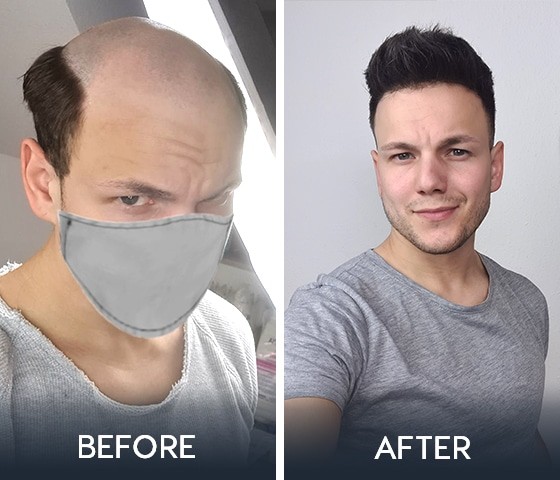Buying First Frontal Hair System: A Complete Guide
Key Points
Know your options before buying – Choosing the right base (lace, poly, or hybrid), adhesive, and density determines how natural and comfortable your frontal hair system will look.
Commit to maintenance – Regular cleaning, touch-ups, and salon visits are essential to extend the lifespan of your system and keep it seamless.
Confidence is the real payoff – A frontal system restores not just your hairline but also your self-esteem, helping you look and feel like yourself again.
How does it feel thinking about getting a frontal hair system for the first time?
Questions flood your mind: Will it look natural? Which base should I choose? Will it hold if I sweat at the gym?
The good news?
You’re not alone—guys across the internet have been asking the exact same things.
The better news?
With the right knowledge, you can skip the rookie mistakes and get a system that blends seamlessly, feels comfortable, and gives you back the confidence you’ve been missing.
This guide breaks down everything you need to know before buying your first frontal hairpiece—from adhesives and density to styling and maintenance.
What Is a Frontal Hair System?
A frontal hair system is designed specifically for men with receding temples or thinning at the front hairline.
Unlike a full topper that covers the crown and mid-scalp, a frontal is a smaller piece focused on just the hairline zone.
Why people choose it:
Here are the common reasons why people choose front hair systems.
- Restores the visible front hairline;
- Lightweight and breathable compared to full systems;
- Keeps most of your natural hair visible;
- Great entry point for men who aren’t ready to shave their whole top.
Think of it as precision repair work for the most noticeable part of your hair.
Choosing the Right Base Material
Your base material makes a huge difference in how natural your frontal hair system looks.
- Poly (Skin) Systems: Super-thin poly bases create the illusion of hair growing right out of your scalp. Easy to clean and apply, but less breathable than lace. Great for beginners.
- Swiss Lace: Soft, breathable, and blends beautifully into the skin. Perfect if you want maximum realism at the hairline.
- Hybrid Bases: A mix of lace and poly, giving you breathability at the front and durability at the sides and back.
If you’re active, sweat a lot, or perform under lights (yes, stage sweat counts), lace or lace-front hybrids help your scalp breathe. If convenience is your top priority, poly might be the way to go.
Adhesives: What Actually Sticks?
One of the biggest beginner worries is whether the system will lift or even fall off.
A properly applied system will not just fall off at the gym or in daily life. The edges may loosen over time, but that’s normal and fixable.
Top adhesive picks:
- Walker’s Ultra Hold: Strong, reliable, widely used. Works especially well with poly systems.
- Ghost Bond Platinum: Less messy, easier for first-timers, and bonds cleanly.
- Glue Pens: Perfect for quick edge touch-ups between salon visits.
The choice often comes down to preference and lifestyle.
If you’re nervous, Ghost Bond is a good training wheels option.
Density: Less Is More
Density is one of the trickiest parts of ordering your first hair system.
Too dense, and it looks like a helmet. Too thin, and it won’t blend.
Pro tip from experienced wearers: always go lighter than you think.
- If you’re under 30, medium-light density works well.
- Over 35? Keep it natural. Heavy-density pieces can look fake against age-appropriate bio hair.
- Many recommend stock systems with 20% less density than the default.
The safest move? Have your supplier set the density during production.
Thinning it yourself with scissors or razors can easily go wrong.
Styling: What Works Best
Frontal hair systems give you back styling freedom, but not every hairstyle works for every wearer.
- Slicked Back or Upward Styles: Show off the hairline if your base is lace or ultra-thin poly.
- Side Part: A timeless option that works with partial frontals.
- Combing Forward: Useful if blending is tricky, since it covers transitions.
A slight curve in the hairline often looks more natural than a perfectly straight line. Subtlety is your best friend.
Maintenance: How Often and How Much?
A frontal system requires ongoing care, just like natural hair—and maybe a little more.
- Daily: Gentle brushing, avoiding tugging near the edges.
- Weekly: Wash with sulfate-free shampoo and condition only mid-lengths to ends. Avoid oils or conditioners near the adhesive areas.
- Every 3–4 Weeks: Professional maintenance or DIY refit. Adhesive is cleaned off, the system is reapplied, and edges are secured.
- System Lifespan: Around 4–6 months, depending on base material, density, and care.
Expect maintenance costs.
One wearer reported £59 every 3–4 weeks for a salon refit, on top of the initial £399 install. Prices vary, but maintenance is part of the commitment.
Must-Have Extras
Besides the frontal system itself, you’ll want a few supporting products:
- Conditioner: Argan oil–based products keep hair soft without breaking down adhesives.
- Sunscreen: Yes, even on your system. UV rays can dry and fade hair.
- Touch-Up Glue: For edge lifts between appointments.
- Detangling Brush: Prevents pulling and shedding.
These small extras add months of life to your system.
Are You a Good Candidate for a Frontal Hair System?
Not everyone is. The success of a frontal depends on where your hair loss is and how your natural hair blends.
Good candidates:
- Strong density in the crown and mid-scalp;
- Only temples or a frontal hairline receded;
- Willing to stick to the maintenance schedule.
Not-so-great candidates:
- Significant thinning between temples;
- Weak crown density (disconnect becomes obvious;)
- Wanting a set-and-forget solution (these require upkeep.)
When in doubt, a full system may be more seamless.
A common regret is starting with a frontal when blending wasn’t realistic.
Common Beginner Questions (and Honest Answers)
Q: Will it fall off if I sweat at the gym?
No. A proper adhesive bond won’t just give up mid-rep. At worst, edges may loosen slightly, which you can fix with a quick touch-up.
Q: Should I buy thinning scissors to reduce density?
Better to order the correct density upfront. Thinning at home is risky and can ruin the unit.
Q: Do I need more than tape and the hairpiece?
Yes. Conditioner, sunscreen, and maintenance tools will extend lifespan.
Q: Is a frontal cheaper than a full system?
Initially, yes—it uses less material and hair. But keep in mind, if your hair loss progresses, you’ll eventually need a full system.
The Confidence Factor
What really comes through when guys share their stories online is the emotional payoff.
After years of styling tricks, hats, or avoiding photos, suddenly you look in the mirror and see yourself again.
A natural, undetectable hairline doesn’t just change how others see you—it changes how you carry yourself.
Professional Insights for Salons and Stylists
For salons, offering frontal hair systems is a game-changer:
- Entry Point Service: Many men aren’t ready for a full system but will try a frontal.
- Repeat Business: Clients return every 3–4 weeks, building loyalty and steady income.
- Upsell Potential: Products like adhesives, conditioners, and shampoos go hand in hand.
- Pathway to Full Systems: As hair loss progresses, you can guide clients from frontal to full coverage.
With suppliers like Newtimes Hair, stylists gain premium access 100% human hair, advanced base materials, and custom densities—making it easier to deliver flawless results.
Final Thoughts: Should You Go Frontal?
If your crown is strong, your sides are solid, and your main concern is that receding hairline staring back at you in the mirror, a frontal hair system can be the perfect solution.
It’s lighter, less invasive, and restores the most visible part of your hair.
But be realistic.
If your thinning extends beyond the temples, it will be hard to blend, and a full hair system may be the smarter long-term play.
Whichever way you go, the keys to success are the same: choose the right density, use reliable adhesives, maintain consistency, and find a skilled stylist who knows their craft—because that’s how hair systems help men reclaim confidence and truly feel like themselves again.
Because in the end, it’s not just about adding hair—it’s about regaining confidence.
And that’s worth every touch-up, every refit, and every bottle of argan oil you’ll ever buy.




















